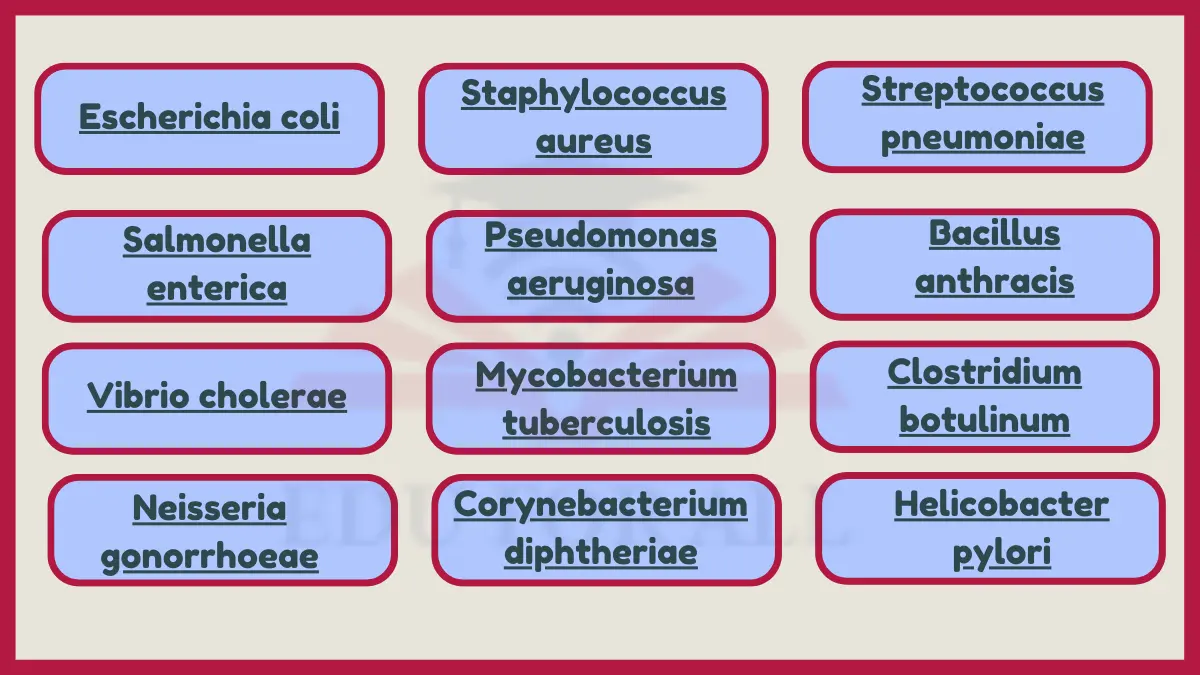Escherichia coli, Staphylococcus aureus, Streptococcus pneumonia, Salmonella enterica, Pseudomonas aeruginosa, Bacillus anthracis, Mycobacterium tuberculosis, and Vibrio cholerae are some most common examples of Bacteria.

- Examples of Bacteria
- 1. Escherichia coli
- 2. Staphylococcus aureus
- 3. Streptococcus pneumoniae
- 4. Salmonella enterica
- 5. Pseudomonas aeruginosa
- 6. Bacillus anthracis
- 7. Vibrio cholerae
- 8. Mycobacterium tuberculosis
- 9. Clostridium botulinum
- 10. Neisseria gonorrhoeae
- 11. Corynebacterium diphtheriae
- 12. Helicobacter pylori
- 13. Lactobacillus
- 14. Cyanobacteria
- 15. Bifidobacterium
- 16. Rickettsia
- 17. Chlamydia
- 18. Legionella
- 19. Mycoplasma
- 20. Borrelia burgdorferi
Examples of Bacteria
Here are some examples of bacteria:
1. Escherichia coli
Escherichia coli are rod-shaped, Gram-negative bacteria. They commonly live in the intestines of humans and animals. While most E. coli are harmless, some strains can cause food poisoning, urinary tract infections, and other illnesses. E. coli are extensively studied in genetics and molecular biology research.
2. Staphylococcus aureus
Staphylococcus aureus are round, Gram-positive bacteria. They often colonize human skin and mucous membranes. However, S. aureus can cause minor skin infections, pneumonia, and serious diseases like sepsis and toxic shock syndrome. Some strains have become resistant to many antibiotics.
3. Streptococcus pneumoniae
Streptococcus pneumoniae are Gram-positive, spherical bacteria. They are a major cause of pneumonia, meningitis, sinusitis, and other respiratory infections. Pneumococcal disease is responsible for high morbidity and mortality worldwide, especially among young children and the elderly.
4. Salmonella enterica
Salmonella enterica are rod-shaped, Gram-negative bacteria. They colonize the intestines of humans and animals. They are a common cause of foodborne illness, including typhoid fever, gastroenteritis, and food poisoning. Salmonella infection usually results from consuming contaminated food or water.
5. Pseudomonas aeruginosa
Pseudomonas aeruginosa are opportunistic, Gram-negative pathogens. They thrive in moist environments. They often infect immunocompromised patients, causing pneumonia and bloodstream infections. P. aeruginosa can be difficult to treat due to high natural antibiotic resistance.
6. Bacillus anthracis
Bacillus anthracis are Gram-positive, rod-shaped bacteria. They produce extremely potent toxins. They cause the disease anthrax, which most commonly affects grazing animals. They can also infect humans exposed to tissue or spores from infected animals. B. anthracis spores are potential bioterrorism agents.
7. Vibrio cholerae
Vibrio cholerae are curved, Gram-negative bacteria that cause the diarrheal illness cholera. They produce a toxin that disrupts ion transport in the small intestine, causing severe watery diarrhea. Cholera can lead to dehydration and death if not promptly treated with fluids and electrolytes.
8. Mycobacterium tuberculosis
Mycobacterium tuberculosis is acid-fast, Gram-positive bacteria. They cause tuberculosis (TB), a chronic lung disease. M. tuberculosis is spread by aerosol droplets emitted by people with active pulmonary TB. If not treated properly, TB disease can be fatal. Multidrug-resistant strains are an increasing global health threat.
9. Clostridium botulinum
Clostridium botulinum are Gram-positive, spore-forming bacteria. They produce botulinum neurotoxin, one of the most potent toxins. Botulinum toxin causes the paralytic illness botulism, which can be fatal without prompt antitoxin treatment. C. botulinum spores are ubiquitous in soil and marine sediment.
10. Neisseria gonorrhoeae
Neisseria gonorrhoeae are Gram-negative cocci that infect urogenital epithelia, causing the sexually transmitted disease gonorrhea. Gonococcal infections can lead to pelvic inflammatory disease, infertility, and disseminated infections if not treated early with antibiotics. N. gonorrhoeae is increasingly resistant to antimicrobials.
11. Corynebacterium diphtheriae
Corynebacterium diphtheriae are club-shaped, Gram-positive bacteria. They cause the upper respiratory illness diphtheria. The bacterium produces diphtheria toxin that can lead to myocarditis, nerve damage, and airway obstruction. Childhood vaccination has largely eradicated diphtheria in developed countries.
12. Helicobacter pylori
Helicobacter pylori are microaerophilic, Gram-negative bacteria. They use flagella to burrow into the stomach lining and inject virulence factors that induce chronic inflammation.
13. Lactobacillus
Lactobacillus are rod-shaped, Gram-positive bacteria used to ferment foods like yogurt, cheese, and sauerkraut. Many Lactobacillus species are normal gut commensals and are taken as probiotics. Their lactic acid production creates an acidic environment that inhibits pathogenic bacterial growth.
14. Cyanobacteria
Cyanobacteria are photosynthetic, Gram-negative bacteria found in nearly every terrestrial and aquatic habitat. Also called blue-green algae, cyanobacteria convert solar energy into biomolecules through oxygenic photosynthesis. They significantly impacted evolution by raising oxygen levels during the Precambrian period.
15. Bifidobacterium
Bifidobacterium are branched, anaerobic, Gram-positive bacteria. They inhabit the gastrointestinal tract. Species like B. longum and B. bifidum are common probiotics. They benefit health by producing vitamins, preventing pathogen growth, and regulating immunity. Certain bifidobacteria are associated with healthy infant gut development.
16. Rickettsia
Rickettsia are tiny, Gram-negative, obligate intracellular parasites. Vector-borne species like R. rickettsii cause Rocky Mountain spotted fever, transmitted via tick bites. Rickettsiae spread by reproducing inside host cells, causing microvasculitis and tissue damage. Rapid diagnosis and treatment with antibiotics like doxycycline are critical.
17. Chlamydia
Chlamydia are non-motile, Gram-negative bacteria that cause ocular, respiratory, and sexually transmitted infections. C. trachomatis causes preventable blindness and pelvic inflammatory disease. C. pneumoniae causes walking pneumonia and respiratory infections. Chlamydiae have a complex developmental life cycle within membrane-bound inclusions in host cells.
18. Legionella
Legionella are fastidious, aerobic, Gram-negative bacteria found in freshwater environments. L. pneumophila causes Legionnaires’ disease, a severe pneumonia acquired by inhaling aerosolized bacteria from contaminated cooling towers or plumbing systems. Risk factors for legionellosis include age, smoking, and immunodeficiency.
19. Mycoplasma
Mycoplasma are tiny, wall-less bacteria that parasitize vertebrate hosts. Species like M. pneumoniae cause atypical pneumonia in humans. Mycoplasmas lack cell walls but have tough plasma membranes that provide structural integrity. They are intrinsically resistant to many antibiotics that target cell wall synthesis.
20. Borrelia burgdorferi
Borrelia burgdorferi is a spiral-shaped, Gram-negative bacteria transmitted by deer ticks. They are the causative agent of Lyme disease. It can manifest with skin rashes, arthritis, carditis, and neurological issues if not treated promptly. B. burgdorferi spreads in the body by escaping phagocytosis and inducing immunosuppression.

